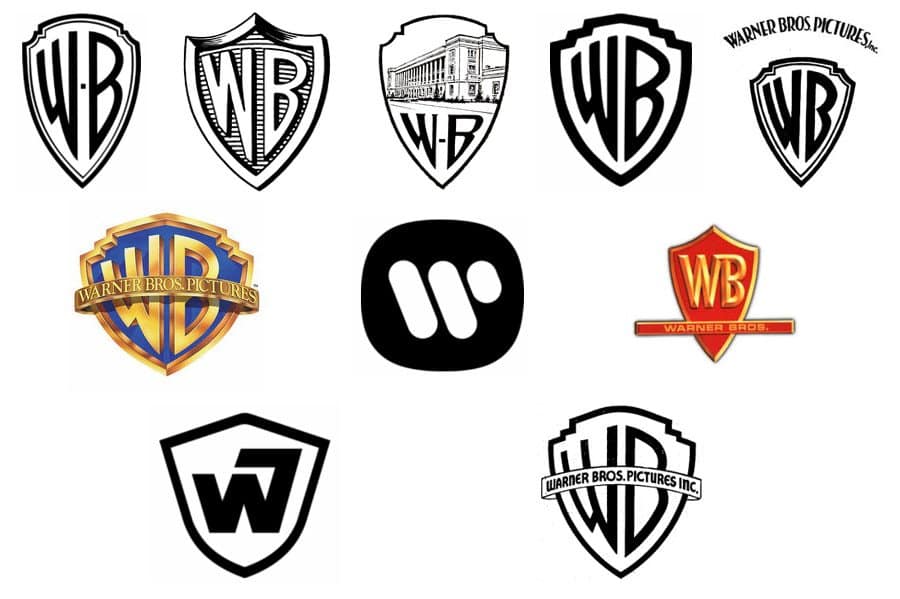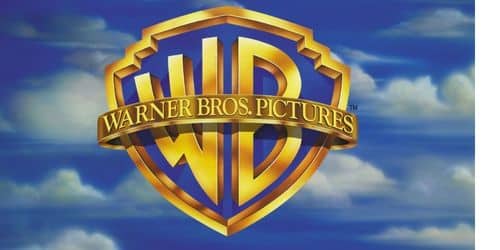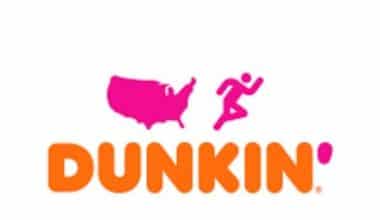Warner Brothers, also known as Warner Bros. Entertainment, Inc., formerly known as Warner Brothers Pictures, Inc. and Warner Bros., Inc., is an American entertainment conglomerate that was founded in 1923 and is best known for its film studio. It was acquired by Time Warner Inc. in 1990. The headquarters of Warner Brothers is located in Burbank, California. Let’s delve into the rich history of Warner Bros films and also see how the logo has evolved over time.
Origin and Founders of Warner Bros.
The company was founded by four brothers: Harry Warner (1881 – 1958) in Hollywood, California, United States, Albert Warner (1884 – 1967) in Miami Beach, Florida, United States, Samuel Warner (1887— 1927), and Jack Warner (1892 – 1978) in Los Angeles, California, United States, all sons of Benjamin Eichelbaum, an immigrant Polish cobbler and peddler.
The brothers began their careers as traveling movie showmen in Ohio and Pennsylvania. They began acquiring movie theaters in 1903 and then moved into film distribution. They began producing their own films around 1913, and in 1917 they relocated their production headquarters to Hollywood, California.
In 1923, they founded Warner Brothers Pictures, Inc. Harry, the eldest of the brothers, was the company’s president and ran its headquarters in New York City, while Albert was the treasurer and head of sales and distribution. Sam and Jack ran the Hollywood studio.
Warner Bros Films History: Sound, color, and style (the 1920s – 1930s)
Warner Bros. was a pioneer in the use of synchronized sound in films (then known as “talking pictures” or “talkies”). They agreed to include this feature in their productions in 1925, at Sam’s urging. The studio had a net loss of $333,413 by February 1926.
After a long period of denying Sam’s request for sound, Harry agreed to change his mind as long as the studio’s use of synchronized sound was limited to background music.
Vitaphone was founded after the Warners signed a contract with the sound engineering company Western Electric. Vitaphone began producing films with music and effects tracks in 1926, most notably in Don Juan, starring John Barrymore. The film was silent, but it began with a large number of Vitaphone shorts. To promote the release of Don Juan, Harry purchased the large Piccadilly Theater in Manhattan, New York City, and renamed it Warners’ Theatre.
On August 6, 1926, Don Juan premiered at the Warners’ Theatre in New York. Throughout the early history of film distribution, theater owners hired orchestras to provide soundtracks at film showings.
In 1926, Warner Bros. released eight short films on Vitaphone (which were shown at the start of every Don Juan screening across the country). Many film production companies questioned the requirement. Don Juan failed to recoup its production costs, and Lubitsch moved on to MGM. By April 1927, Warner’s had been ruined by the Big Five studios (First National, Paramount, MGM, Universal, and Producers Distributing), and Western Electric renewed Warner’s Vitaphone contract with terms that allowed other film companies to test sound.
Read Also; COMPANY INFORMATION: How to Find & Update Company Info in 2022
As a result of their financial difficulties, Warner Bros. released The Jazz Singer, starring Al Jolson. This film, which had little sound dialogue but did include sound segments of Jolson singing, was a hit. It marked the beginning of the “talking picture” era and the end of the silent era.
However, Sam died the night before the premiere, so the brothers were unable to attend. Jack was appointed as the sole producer. Sam’s death had a significant emotional impact on Jack, as Sam was arguably Jack’s inspiration and favorite brother.
In the years that followed, Jack maintained tight control over the studio. Employees were frequently fired. Among those fired by Jack were Rin Tin Tin (in 1929) and Douglas Fairbanks Jr. (in 1933), the latter having been the studio’s top star since the brothers bought it in 1928.
The studio was flush with cash as a result of The Jazz Singer’s success. The Singing Fool, Jolson’s next film for the studio, was also a success. With the success of these early talkies (The Jazz Singer, Lights of New York, The Singing Fool, and The Terror), Warner Bros. rose to prominence, and the brothers were able to relocate from Hollywood’s Poverty Row to a much larger studio lot in Burbank.
They grew by purchasing the Stanley Corporation, a large theater chain. This gave them a stake in First National Pictures, which Stanley owned one-third of. On September 13, 1928, Warner Bros. purchased more First National shares in a bidding war with William Fox; Jack also appointed Zanuck as manager of First National Pictures.
Read Also: Thanksgiving Movies: The 44 Top Best Movies in 2022 (Updated)
The first all-talking feature film, Lights of New York, was released by Warner Bros. in 1928. Because of its success, the film industry almost immediately converted to sound. By the end of 1929, all of the major studios were producing only sound films. Noah’s Ark, First National Pictures’ first film with Warner Bros., was released in 1929.
Despite its high cost, Noah’s Ark was profitable. On with the Show! was released by Warner Bros. in 1929. , the world’s first all-color, all-talking feature. Then came Gold Diggers of Broadway, which ran in theaters until 1939. The success of these films triggered a color revolution.
From 1929 to 1931, Warner Bros. produced color films such as The Show of Shows (1929), Sally (1929), Bright Lights (1930), Golden Dawn (1930), Hold Everything (1930), Song of the Flame (1930), Song of the West (1930), The Life of the Party (1930), Sweet Kitty Bellairs (1930), Under a Texas Moon (1930), Bride of the Regiment (1930), Viennese Nights (1931), Woman Hungry (1931), Kiss Me Again (1931), (1932). In addition to these, a slew of films with Technicolor sequences was released, as well as a slew of Technicolor Specials short subjects. The majority of these black-and-white films were musicals.
Warner Bros. purchased the St. Louis-based theater chain Skouras Brothers Enterprises in 1929. Spyros Skouras, the chain’s driving force, was named general manager of the Warner Brothers Theater Circuit in America following the takeover. He was successful in that position for two years, turning losses into profits.
In the present time, who controls Warner Brothers?
That’s something they consistently fail to take into account. Last Friday, as part of a $43 billion merger, AT&T sold Warner Bros. to Discovery Inc.
Is Disney the owner of Warner Bros.?
Fans of Warner Brothers films may be wondering if Disney has acquired the company. Warner Brothers is not independently owned; AT&T is the parent company. Despite Disney’s inability to acquire Warner Brothers, the two studios have formed a strong working relationship.
Does Warner Brothers still exist?
In addition to New Line Cinema, DC Studios, Castle Rock Entertainment, and Spyglass Media Group, Warner Bros. Pictures is one of five live-action film studios that make up the Warner Bros. Pictures Group.
Read Also: 2022 Fortune 100 List of Companies Updated!!!
Fifty Million Frenchmen was Harry’s adaptation of a Cole Porter musical. The studio’s profit increased significantly thanks to First National. After the success of the Burbank studio’s 1929 First National film Noah’s Ark, Harry agreed to make Michael Curtiz a major director. Mort Blumenstock, a First National screenwriter, rose to prominence at the brothers’ New York office. When Harry purchased the remaining one-third share of First National from Fox in the third quarter, Warner Bros. gained complete control of the company.
The Justice Department agreed to allow the purchase if First National was kept separate. When the Great Depression struck, Warner requested and received permission to merge the two studios. Warner Bros. soon relocated to the First National lot in Burbank.
Despite the merger, the Justice Department required Warner to release a few films under the First National name each year until 1938. For thirty years, certain Warner productions were labeled as ‘A Warner Bros.-First National Picture,’ primarily for tax purposes.
In the latter half of 1929, Jack Warner cast George Arliss in the successful film Disraeli. Arliss was nominated for an Academy Award for Best Actor and went on to appear in nine more films for the studio. Despite the start of the Great Depression, Harry purchased more theaters in Atlantic City in 1930. Motley Flint, the studio’s banker, was murdered in July 1930 by a disgruntled investor in another company.
To form Warner Bros., Harry acquired a number of music publishers, including M. Witmark & Sons, Remick Music Corp., and T.B. Harms, Inc. Music. Warner Bros. purchased Brunswick Records in April 1930.
Harry acquired radio stations, foreign sound patents, and a lithograph firm. Following the establishment of Warner Bros. Lewis, Harry’s son was appointed to manage the company.
Read Also: Why Nokia failed and 4 ways to protect your business
By 1931, the studio was feeling the effects of the Great Depression, reportedly losing $8 million the previous year and another $14 million the following year. Warner Bros. was founded in 1931. Lewis Warner, the music executive, died as a result of an infected wisdom tooth.
Around that time, Zanuck hired screenwriter Wilson Mizner, who had little regard for authority and found it difficult to work with Jack, but who eventually proved to be an asset. With time, Warner grew more tolerant of Mizner and helped fund Mizner’s Brown Derby restaurant. On April 3, 1933, Mizner died of a heart attack.
Harry Warner rented the Teddington Studios in London, England, in the latter part of 1931. The studio focused on producing “quota quickies” for the domestic British market, and Irving Asher was named head producer. Harry officially purchased the Teddington Studios in 1934.
Warner Bros. released 42nd Street, a highly successful musical directed by Lloyd Bacon, in February 1933. Warner put Bacon in charge of “more expensive productions such as Footlight Parade, Wonder Bar, Broadway Gondolier” (which he also starred in), and Gold Diggers, which saved the company from bankruptcy.
Following the success of 42nd Street, the studio produced profitable musicals. Busby Berkeley directed the majority of these, which starred Ruby Keeler and Dick Powell. Berkeley’s arrest for killing three people while driving drunk harmed the revival in 1935. People were tired of Warner Bros. musicals by the end of the year, and the studio shifted its focus to Errol Flynn swashbucklers after the huge profits made by Captain Blood in 1935.
Which businesses does Warner Brothers own?
The Warner Bros. Pictures Group consists of Warner Bros. Pictures, New Line Cinema, the Warner Animation Group, Castle Rock Entertainment, and DC Studios. The television production business Warner Bros. Television Studios is among its other properties.
Does Warner own Six Flags?
n 1993, Time Warner acquired the remaining interest in Six Flags, renaming the firm Six Flags Theme Parks, Inc. from Six Flags Corp.
Is Warner Bros. the owner of Harry Potter?
Rowling and Warner Bros. Entertainment Inc. own the trademark for J.K. Rowling’s Wizarding World. The materials from the Harry Potter film series and Fantastic Beasts and Where to Find Them are provided by Warner Bros. Entertainment.
Warner Bros History: World War II
Prior to the United States’ entry into World War II, Philip Kauffman, Warner Bros. In 1936, the Nazis assassinated Germany’s sales director in Berlin. The Life of Emile Zola, a successful anti-German film, was produced by Harry (1937).
Following that, Harry oversaw the production of more anti-German films, such as Confessions of a Nazi Spy (1939), The Sea Hawk (1940), in which King Philip II was portrayed as Hitler’s equal, Sergeant York, and You’re In The Army Now (1941). Harry then decided to concentrate on making war films. During the war, Warners cut its film production in half and closed its B Pictures unit in 1941. Bryan Foy has joined the cast of Twentieth Century Fox.
During the war, the studio produced Casablanca, Now, Voyager, Yankee Doodle Dandy, This Is the Army, and Mission to Moscow (all 1942), the latter of which became controversial a few years later. Audiences purchased $15.6 million in war bonds for the governments of England and the United States at the premieres of Yankee Doodle Dandy (in Los Angeles, New York, and London).
However, by the middle of 1943, audiences had grown tired of war films, but Warner continued to produce them despite losing money. The Navy named a Liberty ship after the brothers’ father, Benjamin Warner, in recognition of the studio’s contributions to the cause.
Read Also: MERCEDES BENZ: The Untold Story of the World’s No. 1 Car Brand
The ship was christened by Harry. By the end of the war, the studio had purchased $20 million in war bonds, the Red Cross had collected 5,200 pints of blood plasma from studio employees, and 763 studio employees had served in the armed forces, including Harry Warner’s son-in-law Milton Sperling and Jack Warner Jr. Wallis resigned after a disagreement over ownership of Casablanca’s Best Picture Oscar. Bogart’s relationship with Jack deteriorated after Casablanca elevated him to stardom.
Olivia de Havilland (whom Warner frequently lent out to other studios) sued Warner for breach of contract in 1943. De Havilland had refused to play abolitionist Elizabeth Blackwell in a Columbia Pictures film.
Warner retaliated by sending 150 telegrams to various film production companies, advising them not to cast her in any role. De Havilland later discovered that employment contracts in California could only last seven years; she had been with the studio since 1935. The court ruled in favor of de Havilland, and she left the studio in favor of RKO Radio Pictures, and later, Paramount. As a result of de Havilland’s victory, many of the studio’s long-term actors were now free of their contracts, and Harry decided to end the studio’s suspension policy.
The following year, Jack signed newly released MGM actress Joan Crawford, a former top star whose career had begun to fade. Crawford’s first film role was in 1944’s Hollywood Canteen. Her first starring role at the studio, as Mildred Pierce (1945), resurrected her career and earned her an Academy Award for Best Actress.
Warner Bros History: Change of ownership after WWII
Warner Bros. flourished in the postwar years, producing new stars such as Lauren Bacall and Doris Day. By 1946, the company’s weekly payroll had risen to $600,000, and its net profit had surpassed $19.4 million.
Warner released the first color newsreel on January 5, 1948, covering the Tournament of Roses Parade and the Rose Bowl Game. Bette Davis, still their top actress and now hostile to Jack, posed a major problem for Harry in 1948, when she and others left the studio after finishing the film Beyond the Forest.
Warner Bros. had two semi-independent production companies that worked with the studio to release films. Sperling’s United States Pictures was one of them.
The threat of television emerged in the early 1950s. In 1953, Jack made the decision to imitate United Artists’ successful 3D film Bwana Devil by releasing his own 3D films, beginning with House of Wax. However, 3D films quickly lost favor with moviegoers.
3D nearly led to the demise of Warner Bros. Animation. After finishing a 3D Bugs Bunny cartoon, Lumber Jack-Rabbit, Jack Warner closed the animation unit, mistakenly believing that all future cartoons would be produced in 3D.
Warner eventually relented and reopened the cartoon studio. They had a large enough backlog of cartoons and a robust reissue program that there was no discernible disruption in the release schedule.
Warner Bros. released their first film (Carson City) in “Warnercolor,” the studio’s name for Eastmancolor, in 1952.
Read Also: Stock Market Movies: 20 Best Stock Market Movies Of All Time (updated)
Following the demise of 3D films, Harry Warner decided to use CinemaScope in future Warner Bros. productions. The High and the Mighty (owned by John Wayne’s company, Batjac Productions), one of the studio’s first CinemaScope films, enabled the studio to turn a profit.
Warner’s theater holdings were spun off as Stanley Warner Theaters in early 1953; Stanley Warner’s non-theater holdings were sold to Simon Fabian Enterprises, and its theaters merged with RKO Theatres to form RKO-Stanley Warner Theaters.
By 1956, the studio was losing money, down from a net profit of $2.9 million in 1953 and between $2 and $4 million the following two years.
On February 13, 1956, Jack Warner sold all of the studio’s pre-1950 films to Associated Artists Productions (which merged with United Artists Television in 1958 and was later acquired by Turner Broadcasting System in early 1986 as part of Ted Turner’s failed takeover of MGM/UA).
In May 1956, the brothers announced their intention to sell Warner Bros. To purchase 90% of the stock, Jack secretly organized a syndicate led by Boston banker Serge Semenenko. After the three brothers sold, Jack joined Semenenko’s syndicate and bought back all of his stock through an under-the-table deal.
Jack—now the company’s largest stockholder—appointed himself president shortly after the deal was completed in July. Shortly after the transaction was completed, Jack stated that the company and its subsidiaries would be “directed more vigorously to the acquisition of the most important story properties, talents, and the production of the finest motion pictures possible.”
The Warner Bros. Television and Records
By 1949, with television’s increasing success threatening the film industry, Harry Warner decided to focus on television production. The Federal Communications Commission (FCC) would not allow it, however. Harry abandoned his television efforts after failing to persuade other movie studio executives to switch.
Cheyenne was the first hour-long Western on television. Two episodes were combined for release as a feature film outside of the United States. In the tradition of its B movies, the studio quickly produced a series of popular Westerns, including writer/producer Roy Huggins’ critically acclaimed Maverick, as well as Sugarfoot, Bronco, Lawman, The Alaskans, and Colt.45.
The success of these series helped to compensate for losses in the film industry. As a result, Jack Warner made the decision to focus on television production. Beginning with 77 Sunset Strip (1958-1964), Warner Bros. produced a series of popular private detective shows, including Hawaiian Eye (1959-1963), Bourbon Street Beat (1960), and Surfside 6 (1961).
Read Also: SPEAKER BRANDS: Top 15 Best Speaker Brands in the World (2022)
Warner Bros. Records was founded in 1958. Initially, the label released recordings made by their television stars, regardless of whether they could sing or not, as well as records based on television soundtracks.
Warner Bros. already had extensive music-publishing holdings, and their songs had appeared in countless cartoons and television shows (arranged by Carl Stalling and Max Steiner).
Time Warner sold the Warner Music Group, along with Warner Bros. Records, in 2004. was sold to a private equity firm led by Edgar Bronfman Jr. The since-separated Warner Bros. record division was renamed Warner Records in 2019, as WMG held a short-term license to use the Warner Bros. name and trademarks; as a result, the label currently reissues the Warner Bros. back catalog prior to 2019.
Warner agreed to a “rescue takeover” of Frank Sinatra’s Reprise Records in 1963. Sinatra received $1.5 million and a stake in Warner Bros. Reprise Records is now a sub-label of Columbia Records. Most notably, the transaction brought Reprise manager Morris “Mo” Ostin into the company.
Warner decided to claim ownership of the studio’s film soundtracks in 1964, after seeing the profits record companies made from Warner film music. In the first eighteen months of its existence, Warner Bros. Records suffered a $2 million loss.
New Owners
In the late 1950s, Warner Bros. resurrected itself by specializing in adaptations of popular plays such as The Bad Seed (1956), No Time for Sergeants (1958), and Gypsy (1959).
While recovering from a car accident while on vacation in France in 1958, Jack returned to the studio and made certain his name was included in studio press releases. The studio’s annual net profit was slightly more than $7 million from 1961 to 1963.
In February 1962, Warner paid an unprecedented $5.5 million for the film rights to the Broadway musical My Fair Lady. The previous owner, CBS director William S. Paley, stipulated terms that included half of the distributor’s gross profits “plus ownership of the negative at the end of the contract,” resulting in a $3.7 million net profit in 1963.
Motion picture production was in decline by the mid-1960s, as the industry was undergoing a painful transition from the Golden Age of Hollywood to the era now known as New Hollywood. Few studio films were produced in favor of co-productions (for which Warner provided facilities, funding, and distribution) and acquisitions of independent films.
With the success of its 1964 film adaptation of the Broadway plays My Fair Lady, as well as its soundtrack, Warner Bros. Records became a profitable division. “Who’s Afraid of Virginia Woolf?” was released in 1966. was a resounding success.
Read Also: BRAND REPRESENTATIVE: Cities That Pay More to Brand Representatives.
In November 1966, Jack relinquished control of the studio and music business to Seven Arts Productions, run by Canadian investors Elliot and Kenneth Hyman, for $32 million. The studio and the company were renamed Warner Bros.-Seven Arts.
Warner remained president until the summer of 1967 when Camelot failed at the box office and Warner handed over the presidency to his longtime publicity director, Ben Kalmenson; Warner remained on board as an independent producer and vice-president. With the 1967 success of Bonnie and Clyde, Warner Bros. was again profitable.
Two years later the Hymans were tired and fed up with Jack Warner and his actions. They accepted a cash-and-stock offer from Kinney National Company for more than $64 million. Ashley-Famous, whose founder Ted Ashley led Kinney head Steve Ross to purchase Warner Bros.; Ashley-Famous was soon spun off due to antitrust laws prohibiting the simultaneous ownership of a film studio and a talent agency.
Read Also: COCA-COLA BRAND STORY: 5 Growth Attributes (Updated)
Ashley took over as studio president and renamed the company Warner Bros. Inc. once more. The sale of the Hymans infuriated Jack Warner, who decided to go into independent production (most successfully in 1776 at Columbia). He retired in 1973 and died in August 1978 from serious health complications caused by heart inflammation.
Despite the fact that movie audiences had shrunk, Warner’s new management believed in the power of stars, signing co-production deals with several of the biggest names of the day, including Paul Newman, Robert Redford, Barbra Streisand, and Clint Eastwood, and successfully carrying the studio through the 1970s and 1980s.
Its early 1970s hits included the aforementioned actors’ films, as well as comedian Mel Brooks’ Blazing Saddles, Stanley Kubrick’s A Clockwork Orange, The Exorcist, John Boorman’s Deliverance, and Martin Scorsese’s Mean Streets and Alice Doesn’t Live Here Anymore. Warner Bros. also made significant profits from films and television shows based on the DC Comics characters Superman, Batman, and Wonder Woman. Warner Bros. was also present in the 1970s. Records grew to become one of the world’s major record labels, with sister labels Elektra Records and Atlantic Records.
Warner Bros. announced in late 1973 that it had joined forces with 20th Century Fox to co-produce a single film, producer Irwin Allen’s The Towering Inferno. Both studios acquired the rights to books about burning skyscrapers: Warner was attempting to adapt Thomas N. Scortia and Frank M. Robinson’s The Glass Inferno, while Fox was preparing an adaptation of Richard Martin Stern’s The Tower.
Read Also: 9 Business Movies for Entrepreneurs
Allen insisted on meeting with the heads of both studios and announced that because Fox was already ahead with their property, it would be preferable to combine the two into a single film, with Fox owning domestic rights and Warner Bros. handling foreign distribution. The resulting collaboration resulted in the second-highest-grossing film of 1974, turning a profit for both studios and influencing future major studio co-productions. Allen would go on to make more films for Warner Bros., but none would be as successful as The Towering Inferno.
After abandoning parking lots and funeral homes, Kinney renamed itself Warner Communications in honor of its most well-known holding. Throughout the 1970s and 1980s, Warner Communications expanded into new markets, such as video game company Atari, Inc. in 1976 and, later, Six Flags theme parks.
In 1989, Warner Bros. acquired Lorimar-Telepictures and took control of the former MGM studio lot in Culver City, and Sony purchased Columbia Pictures the same year. Sony had plenty of cash on hand, and Warner Bros. now had two studio lots. TBS came to an end in 1990 when Sony purchased the MGM lot from Warner and relocated Columbia to Culver City. Warner, on the other hand, kept the Columbia Ranch, which is now known as the Warner Bros. Ranch.
On December 1, 1980, Robert A. Daly took over for Ted Ashley at Warner Bros. He held the positions of Chairman of the Board and Co-Chief Executive Officer. He was named Chairman of the Board and Chief Executive Officer a year later, and Terry Semel was named President and Chief Operating Officer.
Subsidiaries of Time Warner
In 1989, Warner Communications merged with Time Inc., a white-shoe publishing company. Time claimed greater prestige, while Warner Bros. provided profits. The Time Warner merger was almost derailed when Gulf+Western (later sold to the first incarnation of Viacom) launched a $12.2 billion hostile takeover bid for Time Inc., forcing Time to accept a $14.9 billion cash/stock offer from Warner.
The company responded by filing a lawsuit in Delaware court to dissolve the merger. The amount was lost, and the merger went ahead.
Warner Bros. was founded in 1992. Family Entertainment was founded in order to produce a variety of family-oriented films. In 1994, Jon Peters, whose Peters Entertainment company had a non-exclusive deal with Sony Pictures, received another non-exclusive financing deal from the studio, citing friendship between then-president Terry Samel and producer Jon Peters.
Warner and Tribune Company of Chicago launched The WB Television Network in 1995, looking for a niche market among teenagers. Buffy the Vampire Slayer, Smallville, Dawson’s Creek, and One Tree Hill were among the WB’s early programming offerings.
Seventh Heaven and Charmed, both produced by Spelling Television, helped propel The WB into the spotlight. Charmed was the longest-running drama with female leads, lasting eight seasons. 7th Heaven aired for eleven seasons and was the network’s longest-running family drama and show.
Read Also: Finance Movies: All-Time Top Picks for Newbies & Pros (Updated)
Warner Bros. and CBS Corporation decided to close The WB and CBS’s UPN and launch The CW Television Network together in 2006.
Turner Pictures was folded into Warner Bros. in 1996 as part of the Turner-Time Warner merger, bringing Turner projects like City of Angels and You’ve Got Mail into the studio.
Later that year, Warner Bros. joined forces with PolyGram Filmed Entertainment to distribute a number of films produced by Time Warner subsidiary Castle Rock Entertainment. Also that year, Bruce Berman left Warner Bros. to launch Plan B Entertainment, and he later took over Village Roadshow Pictures with a deal from the studio.
Time Warner sold Six Flags to Premier Parks in 1998. The takeover of Time Warner by then-high-flying AOL in 2000 did not work out, and after the collapse of “dot-com” stocks, the AOL element was dropped from the corporate name.
Warner Bros. celebrated its 75th anniversary in 1998. Terry Semel and Robert Daly resigned as studio heads in 1999, after a career that included 13 Oscar nominations. Daly and Semel were credited with popularizing the modern film production model of partner financing and profit sharing.
Alan F. Horn and Barry Meyer replaced Daly and Semel as new studio heads in mid-1999, and the studio continued to have success in movies, television shows, and cartoons that the previous studio heads had for the studio. Time Warner reorganized Warner Bros. assets under Warner Bros. in late 2003. Entertainment Inc., to differentiate the film studio from its then-sister record label (which became Warner Records in May 2019) and Warner Music Group.
Time Warner, Friends, and Harry Potter’s later Developments
Warner Communications merged with Time Inc. in 1990 to form Time Warner Inc., the world’s largest media and entertainment corporation. Warner Brothers were absorbed into the newly formed company. Following films in the franchise included GoodFellas (1990), The Fugitive (1993), Inception (2010), and Wonder Woman (2017), as well as The Matrix, Harry Potter, and Ocean’s Eleven. On television, Warner Bros. produced two of the most popular shows of the 1990s and early 2000s: Friends and ER. Later television successes included The Big Bang Theory. In addition, Warner joined Tribune Broadcasting to launch the WB, a broadcast television network, in 1995. The WB ran until 2006 when the CW channel replaced it.
Warner Brothers History Timeline
1903
Harry, Albert, Sam, and Jack, the four founding Warner brothers emigrated from Poland to Ontario in Canada. The three elder brothers opened their first movie theater in New Castle, Pennsylvania.
1904
The Warner brothers founded the Duquesne Amusement & Supply Company to distribute films (based in Pittsburgh).
1912
Harry Warner hired an auditor named Paul Chase to look after the accounts.
1918
Warner Bros, the 3rd oldest Hollywood studio (after Paramount and Universal, both founded in 1912), was founded by Jewish immigrants from Poland, originally based on Sunset Boulevard in Hollywood.
1923
April 4th – Warner Brothers Pictures, Incorporated is formally set up.
Rin Tin Tin makes his debut in a short called Where the North Begins. The dog was the first Warner Bros. ‘star’ and was very successful for the studio.
1926
First National Pictures built a studio on a plot of farmland in Burbank.
1928
Warner Bros acquires the studio following the financial and critical success of ‘The Jazz Singer’. Two of the most popular backlot sets Brownstone Street (renamed Ashley Boulevard in 2002) and New York Street was built shortly after.
1929
The new Burbank facility enables Warner Bros to produce movies rapidly – over 86 features in 1929 alone!
The 1930s
Darryl F.Zanuck is employed as production chief working directly under Jack Warner.
With business booming, nine new soundstages were constructed (all still in use today). Meanwhile over on the Warner Hollywood lot, a small administration building was allocated to the animation unit headed by Tex Avery and named ‘Termite Terrace. The name stuck, and any future building used to house the Warner Bros Animation Division was given the same affectionate name.
1935
Stage 16 is completed – the largest soundstage at Warner Bros and one of the tallest in the world. That same year, the entire structure was raised 30 feet, using hand jacks and a lot of labor, to accommodate an elephantine musical, ‘Cain and Mabel’.
Since then, in addition, to housing some of the grandest sets in Studio history, it has been fitted with a tank that holds over two million gallons of water.
1937
The Mill Building, with its myriad crafts departments from the metal shop to scenic art, was constructed in 1937 and still houses these same departments today.
1950s
This decade’s successes include ‘A Streetcar Named Desire,’ ‘A Star Is Born,’ and ‘The Searchers,’ as well as launching James Dean’s career with ‘East of Eden,’ ‘Giant,’ and ‘Rebel Without A Cause.’
1955
The Studio makes a daring foray into the new world of television. The Warner Bros. With the debut of the western adventure ‘Cheyenne,’ television was born. ‘Maverick,’ ’77 Sunset Strip,’ ‘Colt.45,’ and ‘Hawaiian Eye’ were also launched that decade, many of which were filmed on the Studios’ former Western backlot, Laramie Street.
1956
With Alan Ladd, the Studio Jungle set is being built for ‘Santiago.’ It is designed to look like any wooded area and includes a lagoon with a capacity of over 250,000 gallons of water.
1967
The Studio is sold by an ailing Jack Warner to Elliot and Ken Hyman, who rename it Warner Bros.- Seven Arts.
1969
Steve Ross and his Kinney Corporation purchased Warner Bros.- Seven Arts, and the company was renamed Warner Communications, Inc.
DC Comics, which Ross bought with its characters in 1968, was absorbed into the WCI family.
1972
Warner Communications and Columbia Pictures merged to form The Burbank Studios, a single production facility. Serving two of Hollywood’s entertainment titans, the studio resembled a small city with its own fire department, mail services, bank, restaurant, and bicycle shop more than ever before.
At the same time, The Burbank Studios purchased what is now known as Warner Bros. Ranch. The 32-acre facility, adjacent to the Main lot, houses five sound stages and exterior sets, including Park Boulevard and Blondie Street, a circle of residential houses that have hosted beloved television classics such as “Bewitched,” “The Partridge Family,” “Dennis the Menace,” and “I Dream of Jeannie.”
1989
Warner Communications, Inc. acquired Lorimar Telepictures in 1989, bringing the Lorimar library as well as its quality and creative television production arm under the Warner umbrella.
1990
Time Warner, Inc. is formed by the merger of Warner Communications, Inc. and Time Inc., creating one of the world’s largest communications and entertainment companies. In June of that year, the company purchased the entire studio lot and renamed it Warner Bros. Studios with The Celebration of Tradition, a star-studded extravaganza.
2001
Warner Bros. and Time Warner Inc. merged to form the world’s leading media and communications company, with industry-leading businesses including cable networks, cable systems, interactive services, music, publishing, and filmed entertainment.
2004
Laramie Street is demolished and replaced by Warner Village, a residential complex surrounded by production offices.
2007
Park Place is finished, with four-story commercial and residential exteriors finished in brick and stone, paved sidewalks, and a single-lane street encircling a grassy park.
Evolution of the Warner Bros Logo

Throughout its long history, the famous film production company has had many visual identity redesigns, but there were only four official versions of the logo that were not based on the iconic Warner Bros shield with a monogram. The rest of the designs were simply stylizations of the original badge.
Warner Bros Logo: 1923 – 1925
Warner Bros first logo featured a traditional and elegant combination of an arched main wordmark in a bold serif typeface with all letters capitalized and a cursive “Classics of the Screen” tagline. Both were executed in the same black colors and adding sophistication and finesse to the composition.
Warner Bros Logo: 1925 – 1929
The prototype for the company’s current iconic Warner Bros logo was introduced in 1925. It was a sleek white crest with a distinct black outline, with the image of the building on top and a stylized “WB” monogram on the bottom.
Warner Bros Logo: 1929 – 1937
In 1929, the image was removed from the crest, leaving only space for the lettering. The “WB” inscription became bolder and longer, giving it a more professional and elegant appearance. The arched “Warner Bros Pictures” wordmark, executed in all capitals of a custom narrowed font, was placed above the badge.
Warner Bros Logo: 1933 – 1937
In 1933, the badge’s lines were refined, and the additional lettering was removed. Though the previous logo was still in use by the company, the new version was getting more and more popular.
Warner Bros Logo: 1937 – 1967
The main composition was simplified in 1937 by making the letters cleaner and thinner, and the outline was composed of only one line, but an arched banner with the long wordmark crossed the crest in the middle was added.
Warner Bros Logo: 1948 – 1967
The new pattern of the crest added some volume to the company’s logo, which was designed in 1948. The badge’s body was now made up of numerous thin horizontal monochrome stripes, while the letters and frame became thicker and had a bolder outline.
Warner Bros Logo: 1953 – 2019
The flat and bright version of the Warner Bros logo was introduced in 1953 and remained in use for more than sixty years, becoming the most recognizable of all the company’s badges. The crest was narrowed and elegant, with a black background and a thick white frame. The “WB” letters were also done in white, with their contours cleaned and reinforced.
Warner Bros Logo: 1967 – 1970
In 1967, the company merged with Seven Arts, and the logo was redesigned that year. The extra-bold stylized “W7” monogram, executed in thick letters with strict geometric cuts, made it a modern and powerful emblem. The only resemblance to the previous company’s badges was the monochrome color scheme.
Warner Bros Logo: 1970 – 1972
The iconic “WB” crest returned in 1970, but with a new color palette — a red and gold combination that looked sleek and elegant and represented the company from a new perspective. The wordmark was placed on the bottom of the logo, crossing the crest, in a strict straight horizontally stretched banner.
Warner Bros Logo: 1972 – 1990
In 1972, another experimental version of the Warner Bros visual identity was introduced. Saul Bass designed the badge, which had a solid black rounded background and a stylized white letter “W” composed of three parallel diagonal lines with rounded angles. This logo was used by the company for over a decade.
Warner Bros Logo: 1993 – 2019
In 1993, the iconic crest was redesigned. The letters’ and black frame’s lines were bolded, and the shield itself was slightly extended. The arched banners have become thicker and feature black as the main color of the background, with delicate white lettering.
Warner Bros Logo: 2019 – Today
In 2019 Warner Bros continued to use the logo, created for the company in 1953, but changed its color palette to bright blue and white. The crest in solid blue now had no outline, making it appear more friendly and progressive than ever. The traditional iconic shapes of the brand’s visual identity started looking differently in the new combination, reflecting the growth of the company and its ability to change.
Final thoughts
A consistent yet adaptive brand identity is the secret behind the tremendous success of Warner Bros. Over the course of its 100-year history, the company has kept its logo nearly intact while slightly stylizing it to fit different films. The Batman version of the logo, for example, had spectacular wings. The design was customized with icicles to commemorate the release of Polar Express. The film studio spoils moviegoers with hundreds of logo variations, demonstrating its love of experimentation.
Related Articles
- Strategic Alliance: Types & Examples in 2022
- Naming Photography Business: Best Complete 2022 Guide & Creative Ideas
- Stock Market Movies: 20 Best Stock Market Movies Of All Time (updated)
- 9 Business Movies for Entrepreneurs






